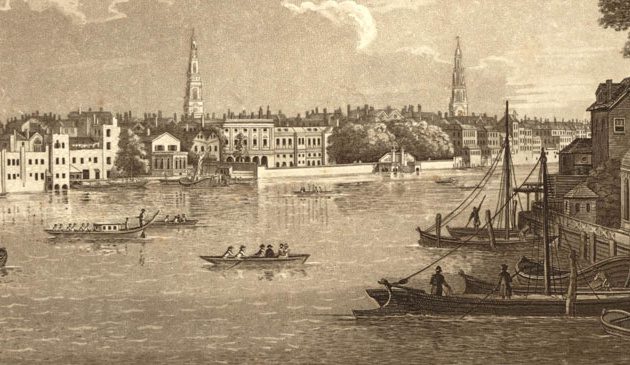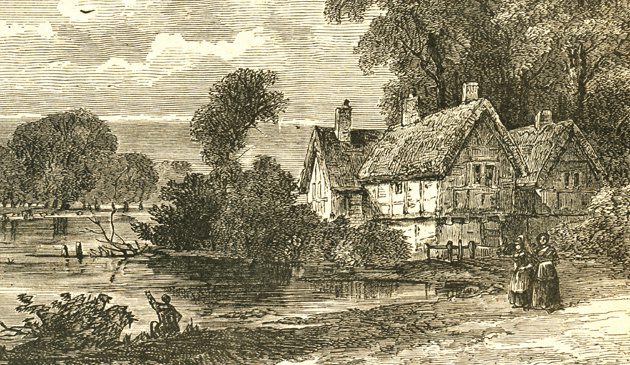In brief – Restoration London

Looking across St. James’s Park towards Whitehall Palace in about 1680, with Banqueting House in the centre, in this engraving published in the 19th century.
It was traditional for apprentices to let off steam during each public holiday but they went a little too far in 1668 when they attacked brothels. The ring-leaders were rounded up and hanged. By the mid-17th century crime in London was becoming rampant, particularly street-crime such as pickpocketing. Travellers to and from London could be targeted by thieves and the image of the dandy highwaymen began with Claude Duval who operated along the Great North Road at Holloway. The most audacious crime of the century was the attempted theft of the Crown Jewels from the Tower of London by Colonel Thomas Blood in 1671.
In the years following the Great Fire the surrounding suburbs continued to succumb to the occasional blaze and Samuel Pepys recorded such an event at Whitehall Palace in November 1666. There was a major conflagration that destroyed much of Southwark in 1676, followed by another in 1689. In 1680 the builder and speculator Nicholas Barbon established the Fire Office in premises behind the Royal Exchange, the first to offer insurance against fires, and the company later became the Phoenix Office. Some insurance companies set up their own services to fight fires. Each of the insured properties fixed a badge to the outside wall in order that firemen employed by the company could identify if the fire was one they should extinguish or not and the first of these began to appear on houses in 1684.
The ancient Bethlehem Hospital for the mentally ill – ‘Bedlam’ – near Bishopsgate was in a poor state of repair. The Mayor commissioned a new building on a nearby site at Finsbury, which opened in 1676. In 1681 the King issued a royal warrant for the creation of a new hospital to care for former soldiers on his land at Chelsea. The Royal Military Hospital, today the home of the ‘Chelsea Pensioners’, was designed by Sir Christopher Wren. There were many delays in its construction and it finally opened in the early 1690s.
In 1673 the Society of Apothecaries obtained the lease on four acres of land on the riverbank at Chelsea to build a boat-house for their processional barge. The following year they started to plant a herbal garden on the site and it proved to be a favourable location. The Chelsea Physic Garden continues today on the same site.
Temple Bar had been the western entry to the City since medieval times when the jurisdiction of the Corporation of London was extended beyond the Roman wall. Although not affected by the fire, Charles took advantage of the work taking place to commission Christopher Wren to design a new gate, which was completed in 1673.
Following the Restoration, great advances in the studies of science, medicine, astrology and architecture took place in England, encouraged by the King and his brother. At the centre of such events was a group of men based in London, Oxford and Cambridge and often referred to in correspondence at the time as being “ingenious” and “virtuosi”. They established a formal association called the Royal Society to meet in London where they could share ideas and the results of their research. A central figure in this group during the Restoration period was Robert Hooke and other enthusiastic members included Christopher Wren, John Evelyn and Samuel Pepys.
As explorers and traders made ever-longer sea journeys, navigation became of greater importance. It was still not possible to accurately know a ship’s position at sea and a number of eminent scientists in England looked for a solution. The amateur astronomer John Flamsteed advised the King that the skies had not so far been mapped accurately enough for the stars to be used for navigation. Charles therefore appointed him as the first Astronomer Royal in order to do so. In 1675 Charles commissioned Wren to build the Royal Observatory on the hill above the old Greenwich Palace, Britain’s first purpose-built scientific research facility. Despite Flamsteed’s work it continued to remain impossible to fix one’s precise position relative to longitude. However, as part of their work at the Observatory he and his successor, Edmond Halley, segmented the globe with lines of longitude from the North to South Poles, with 0º passing through the Observatory.
The Thames, the flow of which was slowed by the medieval bridge, occasionally froze over during cold winters. One of the most famous such occasions was during the winter of 1683-1684 when the river was frozen from December until February and it was possible to hold a Frost Fair on the ice.
In the 1670s the country whipped itself up into a frenzy of anti-Catholicism amid talk of plots to return Britain to Catholic rule. The storm reached a crescendo when one Titus Oates began telling false stories of Jesuit plots to assassinate Charles in favour of his Catholic brother James, leading to the execution of thirty-five people. Charles died suddenly in 1685 without producing a legitimate heir and his brother James, Duke of York inherited the throne as King James II. James had Oates put on trial and jailed.
< Go back to In Brief: Plague and Fire or forward to In Brief: Late Stuart London >


